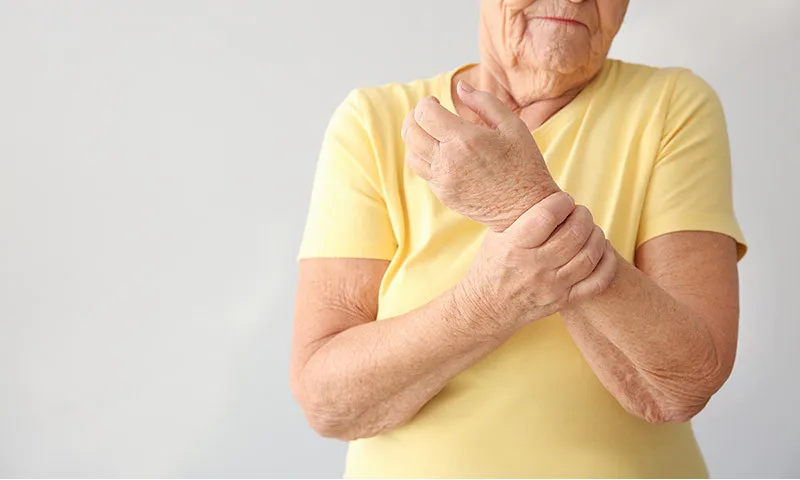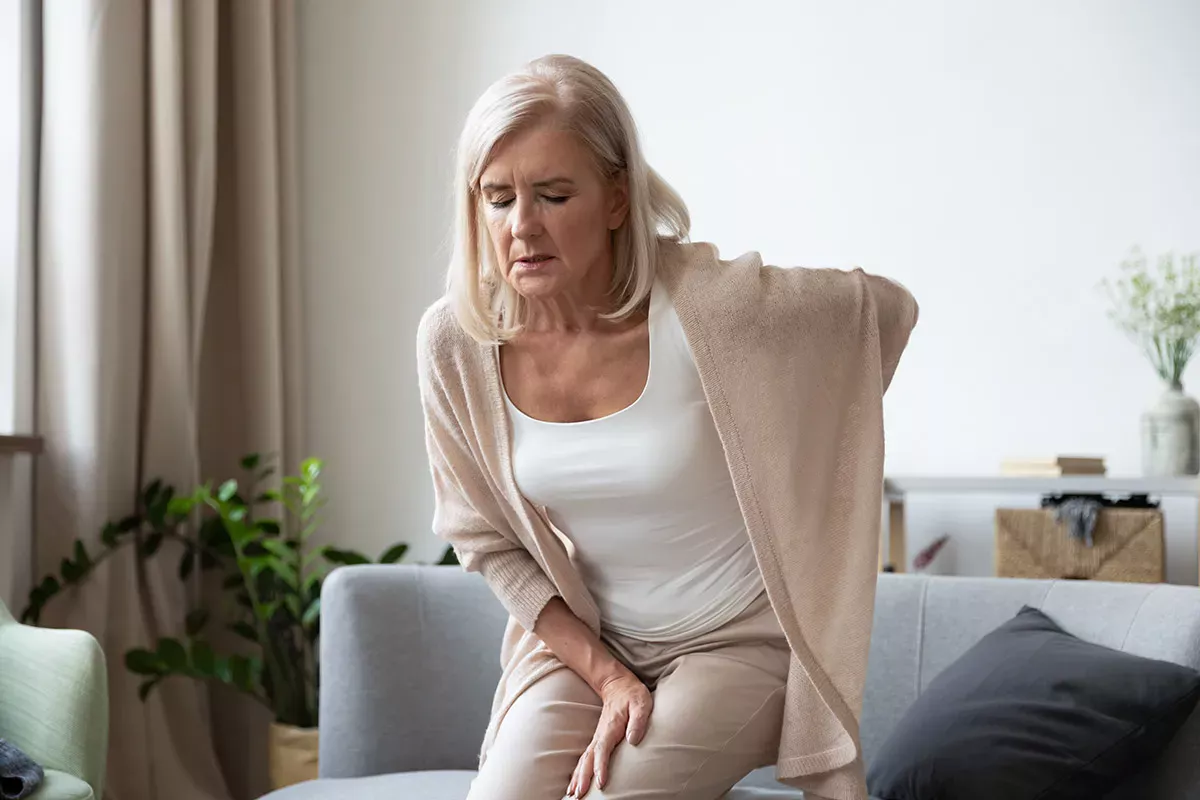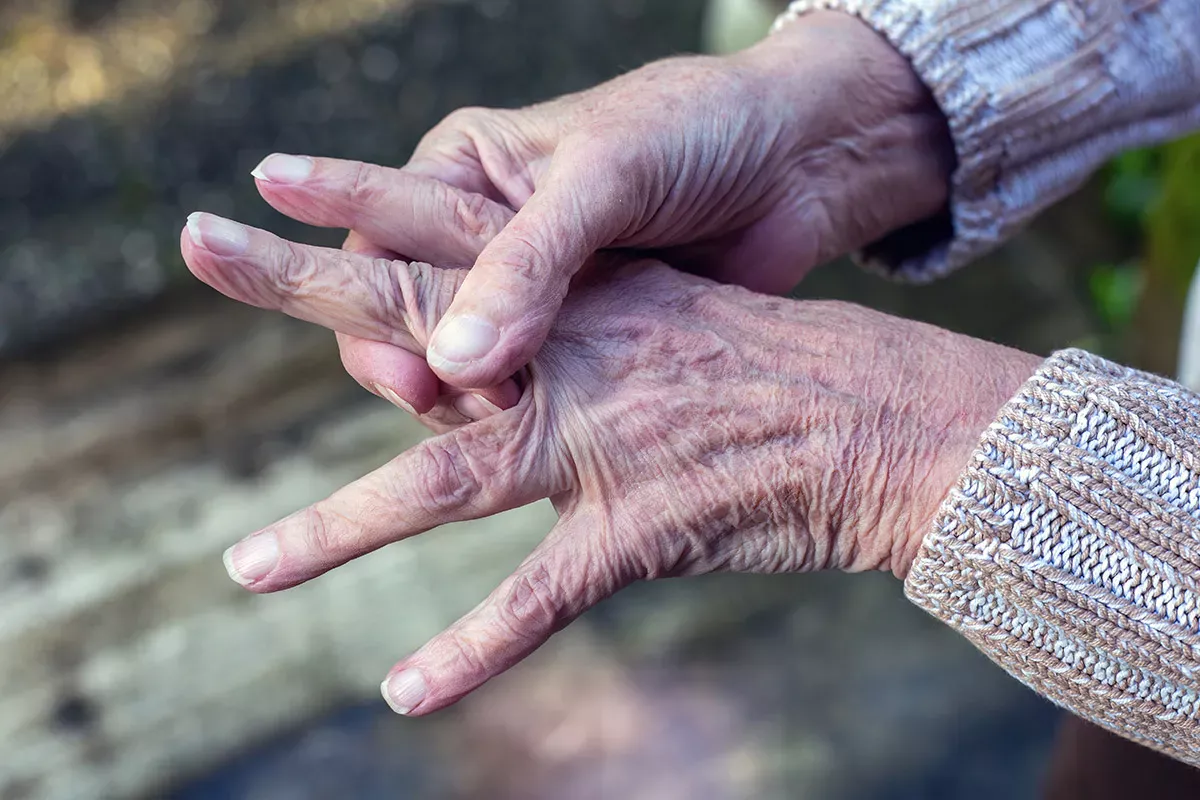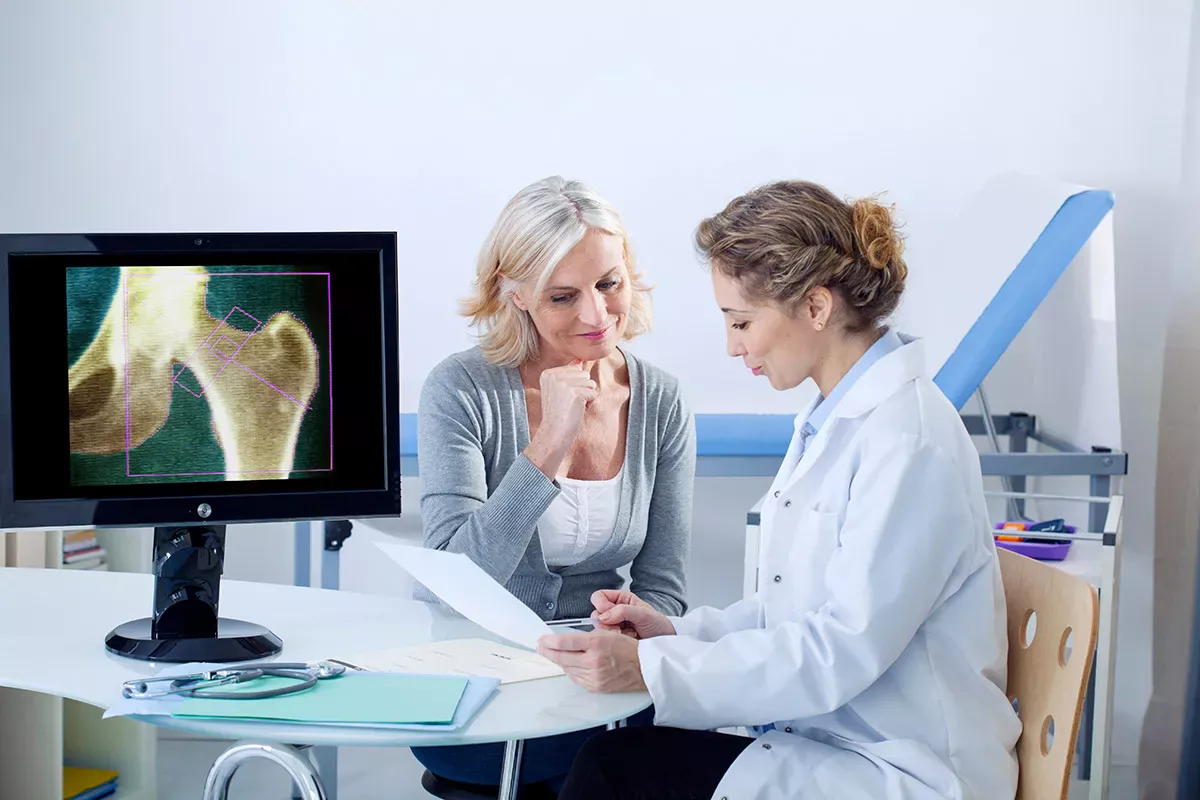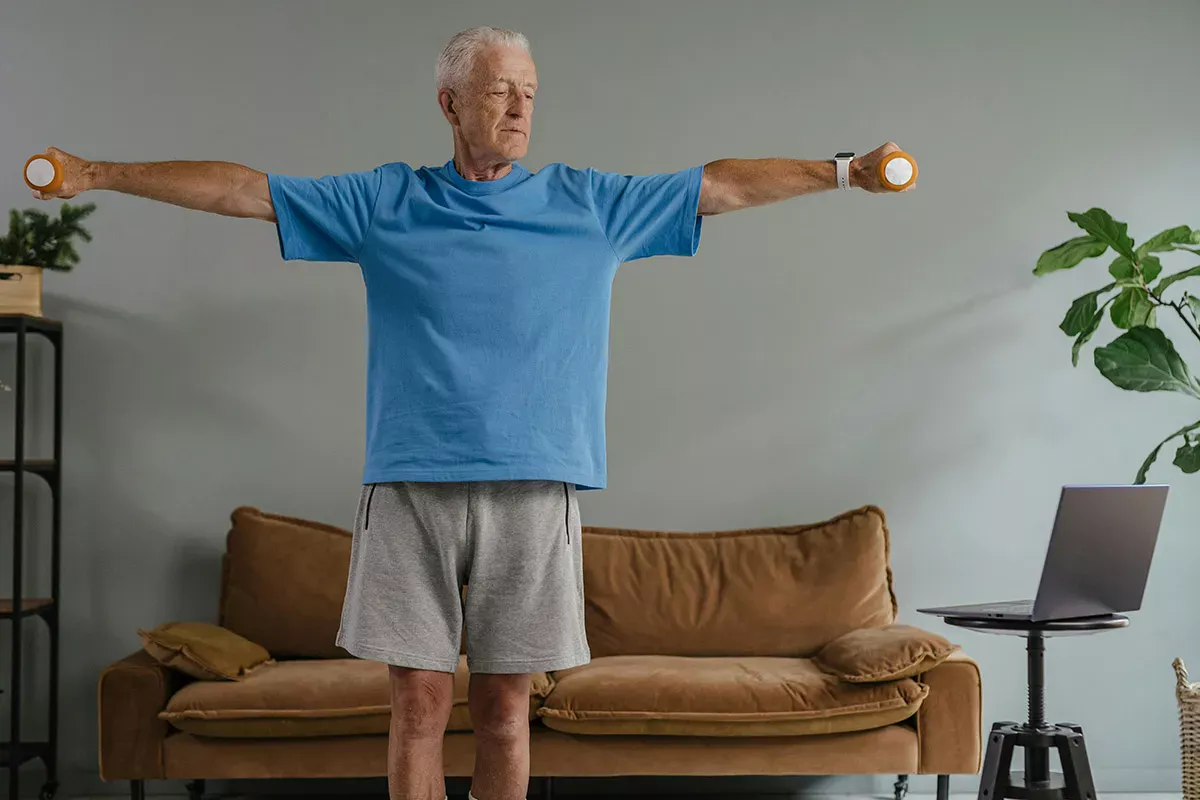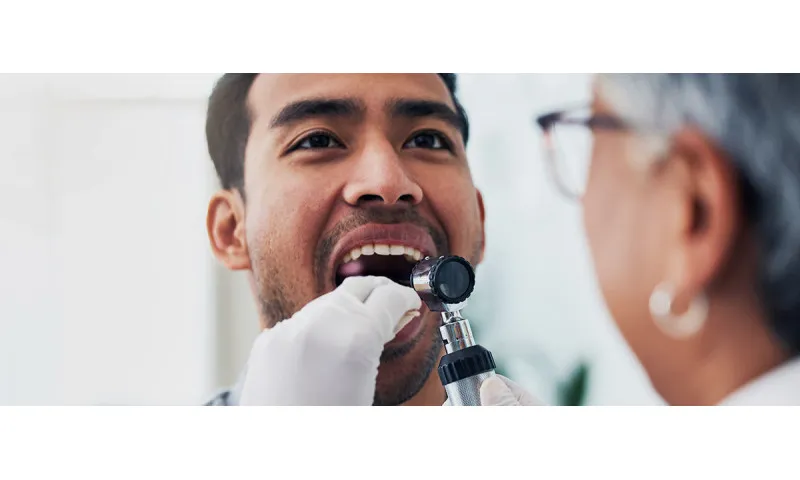Definition : Osteoporosis - what is it?
The chronic disease osteoporosis (coded as M81 in the ICD-10 ) is also known as bone atrophy - and the term hits the nail on the head: in affected people, the structure of the bone tissue becomes coarse and full of holes and the density of the bones decreases. The bones can then break much more easily and quickly than in healthy people.
But why does this happen? To find out, we need to take a look at bone metabolism: Our bones are not simply a "finished material", but are constantly being remodelled throughout our lives. In normal bone metabolism, there is a constant balance between bone resorption and bone formation. Up to the age of 30 or 35, however, bone formation predominates. After that, bone density steadily decreases in all of us; this is completely natural. In people suffering from osteoporosis, however, bone density falls more sharply and more quickly. In these people, the relationship between bone formation and bone resorption is disturbed.
Fortunately, there are treatment options that can delay bone loss - one of these is the administration of bisphosphonates. A very rare side effect of the drug is the development of jaw necrosis. Would you like to find out more about this now? Then read on in the section "Focus on osteonecrosis of the jaw and osteoporosis".
Good to know:
What does ICD mean? The abbreviation stands for International Statistical Classification of Diseases and Related Health Problems - this is an internationally recognised system that uses codes to name and encode medical diagnoses. The codes can be found in documents and doctors' letters.
Who is affected by osteoporosis?
At least six million people in Germany live with osteoporosis. The disease occurs more frequently in older people. Every year, more than 800,000 people over the age of 50newly diagnosed with osteoporosis. Women are affected significantly more often than men - they account for around 80 per cent of all sufferers. Nevertheless, osteoporosis also plays a role in men that should not be underestimated. A third of all men over the age of 50 are affected. The number of new cases is expected to rise in the future due to demographic change.
Women and osteoporosis: why is it more common in women?
As you have already learnt, women suffer from osteoporosis more often than men. In the 65+ age group, almost a quarter of all women are affected. The reason for the susceptibility of older women is the menopause. We explain how this is connected here. But first we have to look back to our youth:
Bone metabolism is controlled and influenced by many different factors. For example, by the thyroid hormone calcitonin and the parathyroid parathyroid hormone, by vitamin D, testosterone - and by oestrogens. Oestrogens influence bone metabolism by stimulating bone formation. From the age of 35, however, the ovaries begin to steadily reduce their activity - ovulation fails to occur more frequently and oestrogen production is reduced. If this results in an oestrogen deficiency, more bone is lost than built up.
However, women need not worry that they will automatically develop osteoporosis as a result of the menopause. Bone loss is caused by many different influences. In other words, various factors have to come together and persist over a long period of time for the disease to develop. You can read more about the risk factors that favour osteoporosis in the section "Causes: Why does osteoporosis develop?".
Bone loss in children
Although osteoporosis mainly affects older people, the disease can also occur in children and adolescents. In these young years they often suffer from severe pain, many bone fractures and lifelong movement restrictions.
The following causes can be responsible for osteoporosis in childhood and adolescence:
- Juvenile arthritis (joint inflammation that occurs before the age of 16)
- Cystic fibrosis (congenital, inherited metabolic disease with viscous mucus in the lungs)
- Anorexia nervosa
- Chronic liver diseases
- Crohn's disease
- Certain medications such as glucocorticoids (hormones involved in metabolic processes), antiepileptic drugs or immunosuppressants
There are also osteoporosis diseases in children whose cause has not been clarified. These may include, for example
- Impaired collagen production in the bones
- Inflammatory immune diseases
- Vitamin D disorders
Important for parents to know: If bones break very often in infancy, osteogenesis imperfecta, the so-called brittle bone disease, is suspected.
Causes: Why does osteoporosis develop?
You have already learnt about some of the causes of osteoporosis - in women, oestrogen deficiency during the menopause plays a major role. This is of course strongly linked to the ageing of women. Age is therefore also one of the factors that make osteoporosis more likely.
You can read about other causes or risk factors that can contribute to the development of the disease here:
- Certain metabolic diseases (type 1 or type 2 diabetes, hyperthyroidism)
- Chronic inflammatory bowel diseases
- Rheumatoid arthritis
- Neurological diseases such as Parkinson's or Alzheimer's
- Certain medications such as cortisone or gastric acid blockers
- Alcohol consumption
- Cigarette consumption
- Underweight
- Significant weight loss
- Too little physical exercise
- Family history (osteoporosis is hereditary )
- After breast cancer - treatment with endocrine therapy
- After chemotherapy
- Vitamin D deficiency and calcium deficiency (vitamin D supports the storage of calcium in the bones, calcium ensures greater bone stability)
- Stress / Mental suffering
Progression of the disease: Stages at a glance
The World Health Organisation (WHO) has divided the progression of osteoporosis into stages, which we would like to present to you here:
Grade 0 - Osteopenia
This stage can also be referred to as the preliminary stage of osteoporosis. Patients do not usually experience any specific symptoms at this stage and no fractures occur. However, the bone is already beginning to lose strength, which can be diagnosed by measuring bone density. However, this preliminary stage would not yet be recognisable in an X-ray. As a result, this phase of the disease often goes undetected.
Grade 1 - Osteoporosis
At this stage, the bone mineral content is significantly reduced. However, it is possible that bone fractures have not yet occurred. However, it is just as possible for a bone to break at this stage without any major cause.
Grade 2 - Manifest osteoporosis
Advanced bone loss can now lead to one to three bone fractures. The resulting pain is often the first symptom of the disease. Osteoporosis can now be visualised not only by bone density measurement, but also by an X-ray, MRI or CT scan. The first vertebral body fractures appear in the form of "fish vertebrae". Vertebral bodies are cylindrically shaped structural elements of our vertebrae. The intervertebral discs are located between them. These vertebral bodies can dent towards the centre due to osteoporosis. On an X-ray, for example, the vertebral bodies then have an hourglass or fish-like shape.
Grade 3 - Advanced osteoporosis
The bone mineral content is now significantly reduced and many vertebral body fractures occur. We can now also speak of a final stage of the disease. The quality of life is usually severely restricted.
Good to know:
Osteoporosis is very stressful, especially in the advanced stages, and is often associated with great pain. However, the life expectancy is not shortened by the disease.
Osteoporosis: recognising symptoms
Osteoporosis is an insidious disease. In adults, it usually progresses without symptoms or complaints at first. These usually only become apparent later on. We have summarised the signs that can then occur for you here.
Bone fractures
Osteoporosis is usually only suspected when bones actually break. It is therefore important to understand that osteoporosis is not centred on a single bone, but affects the entire skeletal system. However, the spine and hips are usually particularly affected. A fracture of the neck of the femur, for example, is typical of the disease. However, so-called radius fractures can also indicate osteoporosis. In this case, the radius breaks at the wrist. This can happen, for example, if you reflexively support yourself with your hands during a fall.
However, osteoporosis can also cause damage to all other bones - for example the knee. Here too, bone loss can lead to a loss of strength and thus cause discomfort. In addition, back pain caused by osteoporosis can lead to poor posture - and this in turn can lead to incorrect strain on the knees. The foot can also break due to bone loss.
Osteoporosis can also manifest itself through symptoms in the fingers - these small bones can also break. Signs include finger deformities, pain and limited mobility of the hands and fingers. And: the jawbone can also be affected. It can also become porous. If this is the case, the teeth may lose their hold and, in the worst case, fall out.
Good to know:
If left untreated, periodontitis can also cause teeth to become loose. This is a widespread inflammation of the tooth bed and the periodontium. Read here how you can prevent it:
Periodontitis: symptoms, causes and treatment
Pain
If not due to bone fractures, osteoporosis is often characterised by pain - especially back pain. It can come on those affected abruptly and spontaneously, it can be sharp, dull, long-lasting and very agonising. Of course, there can also be many other causes behind it - for example osteoarthritis or even bone cancer, but perhaps just muscle tension. However, if you have been suffering from similar complaints for a long time, you should have a medical check-up.
Hunchback
As the disease progresses, the spine can shorten and become curved - this happens when several vertebrae break in a vertebral fracture. This results in a so-called hunchback (or humpback ), which is also known colloquially as a " widow's hump ". Such a hunchback can then also result in back pain and restricted movement. The consequence of a hunchback can also be the so-called "osteoporosis abdomen ". This means that the abdomen bulges outwards because the rounded back pushes soft tissue forwards.
Important to know: A hunched back can also lead to breathing difficulties. The curved spine makes the chest cavity smaller, which can cause or worsen respiratory dysfunction.
Good to know:
Breathing is the most natural thing in the world? Of course it is! But did you know that it's possible to make "mistakes"? Read here how we can positively influence our breathing and how this helps our health:
Learn to breathe properly: here's how
Loss of height
In the final stage of the disease, sufferers may no longer be able to stand up properly because the spine is so severely curved. As a result, they can lose up to 20 centimetres in height.
Osteoporosis: All about diagnostics
Unfortunately, osteoporosis is often not diagnosed until the disease has already progressed - in these cases, a bone fracture may have already occurred or the person affected may be suffering from chronic back pain. Osteoporosis is often even an incidental finding - for example, when a person is x-rayed for other reasons and bone fractures become visible.
Suspected osteoporosis: Which doctor is the right one?
If you want to be specifically examined for osteoporosis, an orthopaedist would be the right place to go. Of course, you can also talk to your GP about your suspicions or concerns. It's best to find a doctor near you to make your visits as easy as possible.
The doctor will then decide on the diagnosis and to what extent it is necessary to refer you to a specialist. He or she will make a recommendation as to whether you are in the best hands at a centre for osteoporosis or at a clinic, for example. Perhaps a cure with a stay in a rehab clinic is also the right option for you after a fracture.
In the following, we would like to explain which examinations you may need to undergo if osteoporosis is suspected:
Examination and medical history
As a first step, your doctor will ask you about your previous illnesses and find out whether you have any risk factors for osteoporosis. You can find out what these are above. Your doctor will also carry out a physical examination. This includes certain test types of tests that can be used to check your mobility. It is also very possible that the distance between your pelvic arch and ribcage will be measured. This is because this decreases with osteoporosis.
Bone density measurement
Bone density measurement is one of the most important diagnostic procedures for osteoporosis. The mineral salt content in the bones can be measured using a special X-ray method called DEXA or DXA (derived from the English term Dual Energy X-Ray Absorptiometry). The mineral salt content provides information about the stability of the bones.
In this type of diagnosis, X-rays are passed through the femoral neck or lumbar spine for five to ten minutes. The principle: the more rays that pass through the bones, the lower the bone density. The result is given as a T-value.
Table of values : Which T-values stand for which stage of osteoporosis?
T-value between 0 and -1: Bone density is normal.
T-value between -1 and - 2.5: Reduced bone density (preliminary stage, osteopenia).
T-value of -2.5 and less: osteoporosis is present.
R X-ray, MRI and CT
X-rays, MRI and CT are generally used for further diagnostics. They are not suitable for the early detection of osteoporosis. The disease can only be recognised on an X-ray, for example, when the bone mass is already reduced by between 30 and 40 percent.
Blood test and urine sample
A relatively new way of recognising osteoporosis in the early stages is to carry out a blood and urine test. Thanks to the urine and blood values, it is possible to recognise after just a few weeks whether calcium is being absorbed or broken down in the skeleton. They also provide information about the functionality of the kidneys and the skeleton. This so-called calcium biomarker screening is sufficient for diagnosis, so that a positive result does not have to be followed by a bone density measurement using X-rays. Patients are thus spared this burden.
Caution when testing in the pharmacy and at home
Some pharmacies offer to test the risk of osteoporosis themselves, for example by measuring bone density on the wrist. There are also home tests (urine tests) to recognise osteoporosis at an early stage. It is important to know: Only doctors are authorised to make a diagnosis. It is therefore advisable to seek medical advice before making a diagnosis on your own. Your doctor will explain to you the right way to get a diagnosis.
What you can do in advance, of course, is an online self-test on the internet. This simply involves answering questions about your diet, previous illnesses or medication intake. This results in a risk profile - so very important: no diagnosis! You will only find out whether you belong to the risk group. If you decide to do this, make sure that you choose a reputable test provider, such as a clinic.
Good to know:
Depending on the extent of the pain and functional impairment, osteoporosis can be categorised as a disability (up to severe disability). A degree of care is also conceivable. The degree of disability (GdB) is indicated on a scale from 20 to 100 in increments of ten. People with a degree of disability of 50 or more have a severe disability.
Treatment for osteoporosis: therapies at a glance
The choice of suitable treatment for osteoporosis depends on many different factors - for example, the stage at which the disease was diagnosed, the age of the person affected and what other illnesses are present. Treatment is therefore very individualised.
Important to know: Unfortunately, osteoporosis cannot be reversed. However, there are good ways to delay the progression of the disease. We present these options here:
Basic therapy
The so-called basic therapy for osteoporosis consists of strengthening bone formation by taking calcium (K2) and vitamin D3; usually in tablet form. This dietary supplement is important because calcium is an important component and building block of bone. And the bone needs vitamin D3 to ensure good bone mineralisation.
Osteoporosis medication
Specialised medication can reduce the risk of bone fractures. Bisphosphonates, which specifically intervene in bone metabolism, are usually used for this purpose. They can be taken as tablets or administered via an infusion or injection. Bisphosphonates are similar to a building block of bone. They can accumulate on the surface of the bone and are stored in the bone tissue for months to years. Your doctor will carefully consider whether to prescribe this type of medication. It is considered to be very effective, but can also cause side effects - such as necrosis of the jaw. You can find out more about this in our chapter: "Focus on osteonecrosis of the jaw and osteoporosis".
Hormone replacement therapy
For women going through the menopause, hormone replacement therapy can help to increase oestrogen levels and thus counteract the loss of bone mass. However, there are also a number of side effects here, which your doctor will discuss with you.
Pain therapy
Even if osteoporosis itself does not hurt, those affected often suffer from muscle tension caused by poor posture, for example. Bone fractures naturally also cause pain. To avoid having to live with pain, those affected can take painkillers and anti-inflammatory drugs; please only do so after consulting a doctor.
Operation - often not necessary
In the past, fractured vertebral bodies were often operated on to stabilise and straighten the fractured vertebral body with bone cement. Alternatively, a balloon can be inserted to straighten the vertebral body. However, new findings show that such operations only make sense in special cases. This is because many vertebral fractures heal on their own - this takes around eight weeks. Sometimes it makes sense to support the healing process with a support corset (orthosis).
Good to know:
Are you worried about the costs of your osteoporosis treatment? You don't have to. Once a doctor has made the diagnosis, the health insurance companies will cover the costs of the examination and remedies such as injections etc. Calcium and vitamin D can also be covered by health insurance if osteoporosis is manifest, i.e. if bones are already broken.
Treatment without medication possible?
Exercise therapy is also a component of osteoporosis treatment. If we get enough exercise and do active strength training, we strengthen our bones and muscles - and this can also reduce pain. To achieve a good effect, sufferers are often prescribed physiotherapy, which is then combined with relaxation and breathing exercises. In physiotherapy, you will usually also be shown exercises to do at home. However, any other sport, such as gymnastics, swimming, aqua jogging or hiking, is also helpful.
Homeopathy and alternative therapy
It would be nice if osteoporosis could be cured naturally with globules and the like. However, there is no evidence of their effect so far, so you should definitely consult a conventional doctor with your symptoms and complaints. As you know, it is important not to delay the diagnosis, but to treat osteoporosis - at best the preliminary stage - at an early stage.
Strengthen your soul
Stabilising the psyche, avoiding stress and looking to the future with optimism are factors that should not be underestimated in the treatment and prevention of osteoporosis. Scientists have long since discovered that the supposed powerlessness in the face of the disease can lead to a vicious circle of pain, immobility, depression and withdrawal from society. If you have been diagnosed with osteoporosis, you should definitely try to realise that there is a lot you can do to maintain or improve your quality of life. Whether it's a guidebook book, self-help group, an exchange with other sufferers in an internet forum or simply a completely new hobby: continue to take an active part in life and defy the disease.
Prevention: tips for a bone-healthy diet and lifestyle
At best, osteoporosis does not develop at all. We can influence this to a certain extent - in addition to exercise, our diet plays a major role here. We have put together a clear overview of what strengthens and protects your bones here:
- Adequate protein and protein intake through foods such as dairy products, fish or nuts
- Sufficient intake of vitamins
- Calcium intake from foods such as cow's milk, yoghurt, gouda, green vegetables such as spinach leaves and broccoli, calcium-rich mineral water (over 150 milligrams per litre)
- Eat and drink whole foods according to the ten rules of the German Nutrition Society (for example, the "Mediterranean diet" is healthy, for which you can also find many recipes online )
- Only use table salt in small quantities
- Consume alcohol only in small quantities
- Give up smoking
- Exercise regularly
- From mid-April to mid-October, spend 20 to 30 minutes a day outdoors between 11 a.m. and 3 p.m. to ensure vitamin D intake from sunlight.
Good to know:
Vitamin D strengthens our bones. It also prevents the development of rickets, a disease that mainly affects children. Read our article to find out what exactly is behind this and how you can ensure that your child is getting enough vitamin D:
Preventing and treating rickets in children
Focus: Osteonecrosis of the jaw and osteoporosis
Many patients with osteoporosis take bisphosphonates, which specifically intervene in bone metabolism, inhibit bone resorption and can therefore maintain strength. As a very rare but serious side effect, this can lead to so-called jaw necrosis. The diagnosis is usually extremely devastating for those affected. A good piece of advice is not to look at images on the internet about the disease and to remain calm. There are many ways to stop the disease. Your doctor will certainly be able to give you good advice. You can find important initial information about the disease here.
What is jaw necrosis?
In the case of jaw necrosis, parts of the jaw bone or the entire jaw bone dies off. The disease is characterised by the fact that parts of the bone are exposed and the wounds do not heal even after weeks. The reason for the death is an insufficient blood supply to the bone and a lack of oxygen, nutrients and minerals.
The symptoms of jaw necrosis often develop non-specifically. Possible complaints are
- Pain in the jaw area
- Toothache
- Recurrent inflammation
- Tooth loosening
- Progressive bone loss
- Failure of the bone and gums to heal after tooth extraction
- Bad breath (halitosis)
- Abscesses with fistula formation
- Swollen, reddened gums
- Feeling of numbness and heaviness in the jaw
- Difficulties with eating and speaking
- Jaw lock
Why do bisphosphonates favour jaw necrosis?
The connection between taking a corresponding medication and the development of jaw necrosis has not been conclusively clarified. Experts suspect that germs penetrate past the teeth into the jaw. Because bisphosphonates apparently weaken the immune defence of the jawbone, the germs in the bone now have an easy time of it. This results in inflammation in the jaw, which can lead to tissue destruction. Important to know: it is assumed that taking medication is not solely responsible for the development of jaw necrosis, but that several factors play a role.
These risk factors include
- Pre-existing diseases of the teeth, gums and jawbones (especially chronic gingivitis with pocket formation and a high bacterial count)
- Previous procedures and operations on teeth and gums
- Taking medication that affects the immune system
Good to know:
Inflammation of the gums should not be taken lightly. If left untreated, it can develop into an inflammation of the entire periodontium (periodontitis). You can read about how to prevent gum inflammation and how it can be treated here:
Treating osteonecrosis of the jaw - surgery is often unavoidable
Once the diagnosis has been made, the most important initial goals are to relieve the affected person's pain and stop the spread of necrosis. Patients often receive intravenous antibiotic therapy. Unfortunately, however, this measure is usually not enough to treat jaw necrosis completely - this usually requires surgery.
During such an operation, the necrotic bone parts are surgically removed. The surgeon then covers the areas with the help of bone replacement materials. In some cases or in complicated cases, the necrosis may flare up again, making further surgery necessary. In extreme cases, for example, a partial resection of the lower jaw (partial removal of the jaw) is unavoidable. The jaw is then stabilised with metal plates and screws. Later, after good healing, reconstruction with the patient's own bone can be considered.
Good to know:
If osteonecrosis of the jaw is recognised very early, improving oral hygiene plus oral antibiotics can bring about an improvement. You can find out how to brush your teeth optimally here:
Sources:
Aerzteblatt.de: Oncology: Jaw necrosis after high-dose bisphosphonate therapy.
AWMF Guidelines: Prophylaxis, diagnosis and therapy of osteoporosis.
Federal Ministry of Health: M81: Osteoporosis without pathological fracture.
Bundesselbsthilfeverband für Osteoporose e.V.: Osteoporosis and menopause and: Osteoporosis and nutrition.
Federal Centre for Health Education: Osteoporosis prevention is particularly important for women.
Charité: Drug-associated necrosis of the jaw.
Deutsche Apotheker Zeitung: A sensible action? Bone density measurement in the pharmacy.
German Cancer Research Center: Bisphosphonates and denosumab in cancer: bone-stabilising therapy.
Deutsche Rheuma Liga: Therapy for osteoporosis: jaw health at a glance and: Osteoporosis: Causes, symptoms, therapy and: Osteoporosis medication.
dv-osteologie.org: DVO Guideline Osteoporosis 2023.
Eismann-Lindner, Helga: Mental strength stabilises the bones in osteoporosis.
Gesund.bund.de: What are ICD and OPS codes?
Helios Kliniken GmbH: Osteoporosis and the importance of vitamin D.
Internisten im Netz: Osteoporosis: Effects & complications and: Osteoporosis: Causes and: Osteoporosis: Prognosis & Progression and: Osteoporosis: Diagnosis and: New test enables earlier and radiation-free detection of osteoporosis.
Klinikum Dresden: Osteoporosis.
LMU Clinical Centre: Jaw necrosis.
Medical-tribune.de: Osteoporosis: Don't forget to measure bone mineral density in breast cancer.
monitor Health services research: Osteoporosis in children and adolescents.
NDR.de: Osteoporosis: Recognising symptoms, initiating the right therapy and: Osteoporosis: Vertebral fracture surgery often unnecessary.
Orthinform.de: Osteoporosis.
Osteoporosis Centre Munich: Osteoporosis symptoms: Recognise and treat early.
OSD Osteoporose Selbsthilfegruppen Dachverband e.V.: Osteoporosis and back pain.
Public Health Portal Austria: Osteoporosis: Symptoms & Diagnosis.
Pflege.de: Osteoporosis.
Schön Klinik SE: Osteoporosis.
Dresden Municipal Hospital: Osteoporosis.
Stiftung MyHandicap gemeinnützige GmbH: Degree of disability table: What is it and what use is it?.
Thieme-connect.de: Classification according to severity.
University Hospital Düsseldorf: Osteonecrosis of the jaw.
University Hospital Magdeburg: Osteoporosis: When bones become brittle.
University Hospital RWTH Aachen: Osteonecrosis of the jaw.
University Hospital Zurich: Cystic fibrosis.
University Medical Centre Schleswig-Holstein: Late and long-term effects of cancer treatment.
Zahnboutique Kreuzplatz: Osteoporosis in the jaw.
All websites last visited on 07/02/2024
 Swiss premium oral care
Swiss premium oral care
